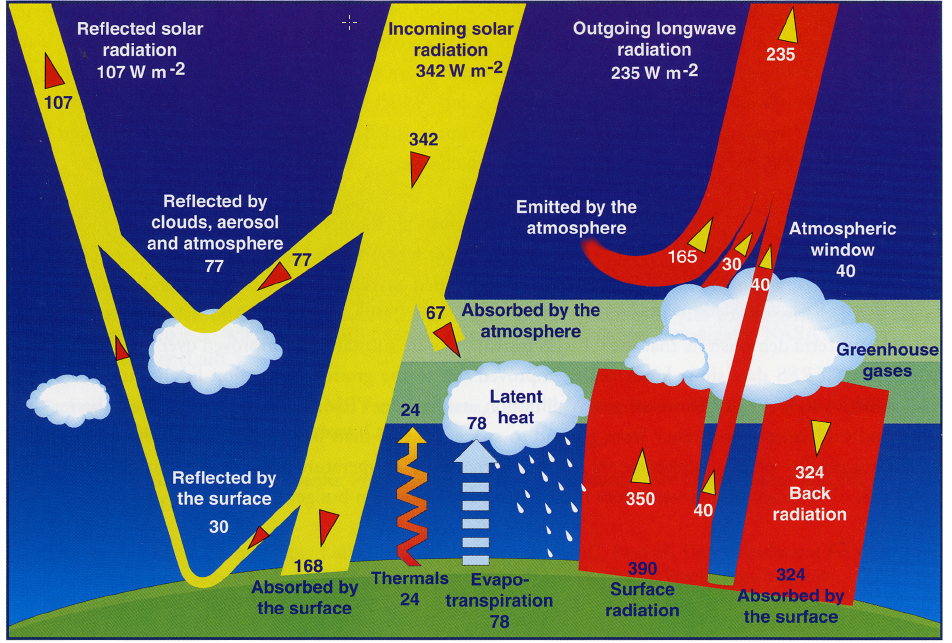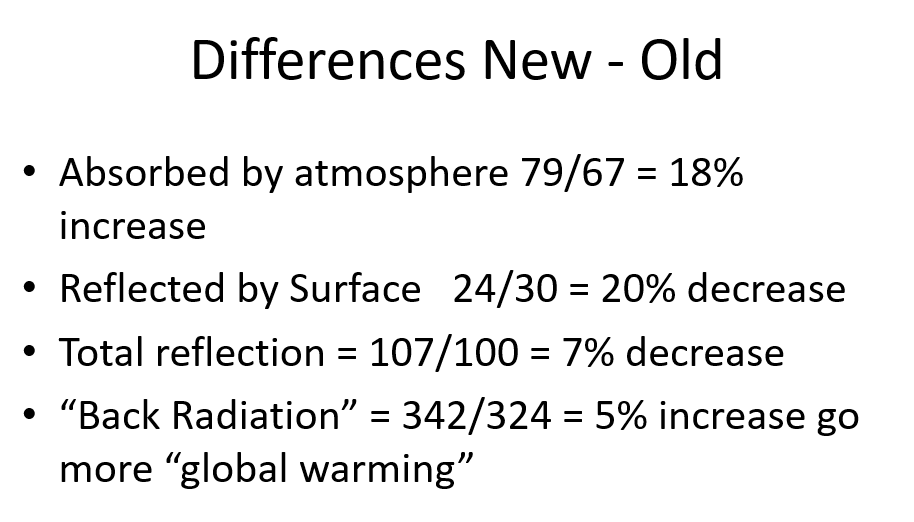The Earth's Radiation Balance
The overall balance between incoming solar radiation and outgoing radiation can be summarized in the figure below. Note that incoming solar radiation is mostly optical light and outgoing radiation from the Earth is infrared. Basically, sunlight heats the Earth up to some characteristic temperature and that heated Earth re-radiates this temperature in the infrared part of the spectrum.

As of 1980 or so, the radiation balance is shown in the figure below.
These diagrams may appear complicated and too difficult to understand but they are not, if you look at the diagram step by step.
Let's start from the beginning:
- 342 watts per square meters gets through the upper layers of our atmosphere
- of that 107 is directly reflected back into space from clouds and surfaces. The Albedo
of the earth is therefore 107/342 = 31%
- that leaves 235 watts per square meter of solar energy input into the atmosphere and the surface
- 67 of that 235 is absorbed by the atmosphere leaving 168 to reach the surface as short
wavelength light.
- Now remember that finite temperature atmosphere? We get 324 watts per meter of long wavelength
radiation emitted back from the atmospehre to the surface. That means the surface gets a total of
324+168 = 492 watts per square meter. Since the earth is in temperature equilibrium (on average) then
the Earth's surface must emit back those 492 watts per square meter.
- It does so via three channels:
- Direct thermal (rising air) = 24 (not much)
- Release of water vapor contained in plants and soil = 78
- Direct surface radiation = 390
- Now out of that 492 watts per square meter, only 235 can go back into space. So
257 watts goes back into the system.
- of the 390 emitted by the surface 40 goes back into space directly through an
atmospheric absorption free window.
- The other 350 is absorbed by the atmosphere as an additional heating source but 324
comes back to the ground
- The net heating of the atmosphere is then (350-324) = 26 + 24+ 78 from ground sources = 128 =
67 from the sun = 195 watts per square meter. That has to be directly remitted back to space
to keep the atmosphere (on average) in thermal equilibrium
- Add that 195 units to the 40 units clear channel and you get 235 emitted back into space
- Voila, Earth In Balance!
There are two principal activities of humans that modify the pathways
shown in this diagram:
- For the incoming end (yellow) industrial processes (and volcanic ones) produce
sulfate aerosols. This changes the short wavelength scattering properties of the atmosphere
 in principle this could lead to global dimming (there is some evidence of this) as less optical sunlight reaches
the ground and more is reflected by the atmosphere (so the 77 number increases).
in principle this could lead to global dimming (there is some evidence of this) as less optical sunlight reaches
the ground and more is reflected by the atmosphere (so the 77 number increases).
- For the outgoing end (red) fossil fuel combustion together with methane release increases the
radiation absorbed by atmosphere which means mor "Back Radiation" which means less than
235 watts per square meter can escape, and the Earth Warms UP.
In the climate modeling community, these alterations are called climate forcings and they are expressed in physical
Flux units of watts per square meter.
As of about 2010, the 1980 situation shown previously has been updated to show slight differences in our radiation balance. These differences reflect how human activities have changed the system in terms of its numerical rates. The new balancing figure is shown below:


These differences represent human activities that have changed some characteristics of the land surface and the nature of particles in the atmosphere. The Net effect is to make the Earth slightly less reflective so it absorbs even more incoming solar radiation and then accelerates CO2 induced warming, which is clearly seen in the higher amount of back radiation between these two images.
|

 in principle this could lead to global dimming (there is some evidence of this) as less optical sunlight reaches
the ground and more is reflected by the atmosphere (so the 77 number increases).
in principle this could lead to global dimming (there is some evidence of this) as less optical sunlight reaches
the ground and more is reflected by the atmosphere (so the 77 number increases).